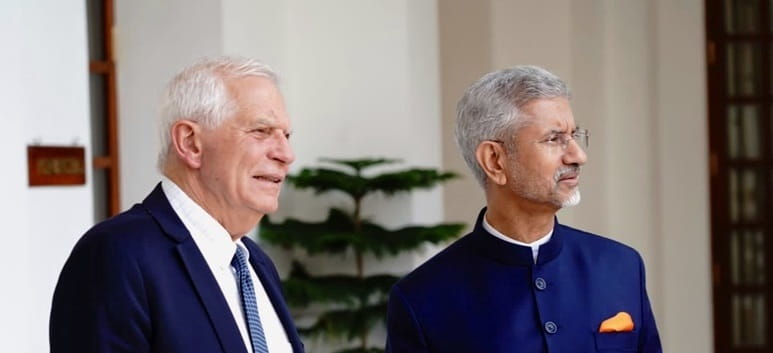
Source: ANI

The EU and India are increasingly aligned from a geo-strategic standpoint. For the partnership to flourish, however, a pragmatic way forward within critical issue areas is needed while keeping different worldviews and normative divergences in check.
Introduction: Rationale and Key Argument
The recently-published Chaillot Paper titled ‘EU-India Relations: Gaining Strategic Traction?’ by the EU Institute for Security Studies (EUISS) dwells into the EU-India relations through a fresh lens, considering how much has already been written on the topic. The paper seeks to answer the following question: ‘How to better fit the EU and India’s geo-strategic interests across worldviews and issue areas?’.
EU-India relations have long had a narrow focus on trade and economic-related issues. The relationship is still very much defined by substantial trade and investment flows: the EU has recently become India’s first trade partner and the EU is one of its largest sources of foreign direct investment (FDI).1 New Delhi remains the tenth trade partner for the EU according to 2022 data.2 Notwithstanding the positive trajectory of the trade relations, the paper argues the need to seize new opportunities for cooperation while highlighting underlying differences in outlook across critical issue areas.
This should allow EU and Indian policymakers to overcome the difficulties caused by mismatched expectations and identify potential areas of convergence. The paper specifically refers to how New Delhi’s acquiescence with Russia’s invasion of Ukraine was not welcome across European capitals; yet there were no serious consequences for New Delhi beyond mild requests for India to publicly condemn Russia’s behaviour. This proves how the geo-strategic importance towards one another is too important to hobble the partnership.
The paper further highlights the normative dimension and, in particular, the diverging worldviews and existing challenges to normative alignment between the EU and India. While pragmatism is an imperative for the relationship to continue to move forward, the main stumbling blocks lie precisely amidst divergences in worldviews and normative alignment. Whatever tangible potential for cooperation exists must be addressed within these parameters in order to achieve a deeper partnership.
Across the seven chapters, we have analysed specific dimensions of EU-India cooperation and examine how common ground might be leveraged through specific actions moving forward. The growing importance of economic security and supply chain resilience has raised the strategic dimension of their relationship with a focus on connectivity, critical and emerging technologies, security and defence, as well as climate change.
Broader Geo-Strategic context

Source: European Union 2024
The paper starts by taking stock of the current shifting international order to contextualise the bilateral relationship. Both India and the EU need to re-define their partnership to Washington and to the developing world, respectively, while seeking a ‘middle way’ between the US and China. There are unprecedented challenges to the existing world order in an attempt to divide the world between ‘like-minded’ vs. ‘non-like-minded’ countries, which does not reflect the grey reality of today’s order. In parallel, the EU is shifting from a strategic autonomy approach to one of strategic interdependence.3 India remains grounded on strategic autonomy and increasingly self-reliance - Atmanirbhar Bharat.4 The nature of international relations has become growingly transactional, which does not make the normative dimension neglectable, however.
Focus on the normative
The paper starts with a section on ‘EU-India Worldviews and Normative (Dis-)Alignment’ which highlights diverging worldviews and the challenges of normative dis-alignment towards achieving deeper and enduring EU-India relations. Both actors need to better understand where they are coming from. In the first chapter, the authors refer to India and the EU’s differing self-conceptions as civilisational entities, geo-political powers and cosmopolitan or international powers. Going forward, both actors will have to accept the differences in their core political values and deal with them based on their shared geo-strategic calculations. They do converge, nonetheless, in their delivery of global public goods while facing common security challenges, such as terrorism, cyberattacks or the disruption of critical supply chains.
In the second chapter, the paper addresses India’s differing views on international norms and on the nature, function and underlying principles of a post-1945 international order, for instance, on human rights, humanitarian intervention or democracy promotion.
India contests both the liberal and truly international nature of the international order, having advocated for reformed multilateralism and a stronger role at the high table of international politics for decades. New Delhi’s claims are now gaining momentum with its enhanced power and capabilities. The EU, as a traditional power, is much more conservative in its views on the need for reform of the international order. Notwithstanding, both actors align on key norms such as economic openness, multilateralism or territorial integrity.
Focus on critical issue areas
The second section of the paper focuses on ‘Critical Issue Areas’ of potential convergence in a growing geo-strategic EU-India partnership. In the third chapter, we focus on the EU’s interest in India’s vast economic potential and New Delhi’s emphasis on the EU’s balancing role in a multipolar order. This translates into the need to go beyond trade, supporting connectivity initiatives, such as the 2021 EU-India Connectivity Partnership or the envisaged India-Middle East-Europe Economic Corridor (IMEC). It further includes advancements in the EU-India Trade and Technology Council (TTC). TTC is a framework which EU has only with India and the US. An MoU on Semiconductors was signed between EU-India in November 2023 as part of the TTC. In addition, convergence exists in both actors’ quest for supply chain resilience and for critical raw materials supplies, as their membership in the US-led Minerals Security Partnership shows.
In the fourth chapter, we shed a light on the substantial potential for collaboration in initiatives around critical and emerging technologies, beyond cyber and internet governance. Collaboration is expanding to include issues of cyber- and data sovereignty. Yet normative and regulatory disparities exist between the EU and India in the technology realms: while India has a ‘state-centric’ focus, particularly in areas like Artificial Intelligence (AI) and data security, the EU has a ‘user-centric’ approach. Yet the EU and India could focus on digital transformation via digital public infrastructure (DPI), personal data and cybersecurity going forward.
In the fifth chapter, the focus turns to EU-India security and defence relationship, which has historically been put on the backburner due to the prioritisation of economic interests. Evolving geo-political priorities of both actors have brought them closer together in their security partnership.
There is an ongoing shift towards strengthening this aspect of the partnership based on mutual geo-economic interests linked to securing the free flow of trade along sea lines of communication (SLOCs): this has encouraged maritime cooperation. The co-development and co-production of defence equipment is further on the agenda, with a strong interest on the part of New Delhi.
In the sixth and final chapter, the potential common agenda on climate change and energy is explored based on how the EU and India position themselves when it comes to equity and social justice. The authors address divergences in climate ambitions, policies and delivery timeframes, with specific recommendations for cooperation on resource optimisation, technological and financial cooperation. Climate change financing needs particular attention, as well as the alignment of trade requirements with global decarbonisation. EU and Indian perspectives on climate change and energy can be reconciled if effective and reciprocal cooperative action is pursued, notwithstanding the tensions around the EU’s Carbon-Border Adjustment Mechanism (CBAM).
Conclusion
The EU and India are increasingly aligned from a geo-strategic standpoint. For the partnership to flourish, however, a pragmatic way forward within critical issue areas is needed while keeping different worldviews and normative divergences in check.
Endnotes: